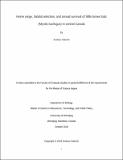| dc.contributor.author | Habrich, Andrew | |
| dc.date | info:eu-repo/date/embargoEnd/2021-12-18 | |
| dc.date.accessioned | 2018-12-18T22:30:49Z | |
| dc.date.available | 2018-12-18T22:30:49Z | |
| dc.date.issued | 2018-10 | |
| dc.identifier.citation | Habrich, Andrew. Home range, habitat selection, and annual survival of little brown bats (Myotis lucifugus) in central Canada: A thesis submitted to the Faculty of Graduate Studies in partial fulfillment of the requirements for the Master of Science degree, Department of Biology Master of Science in Bioscience, Technology, and Public Policy, University of Winnipeg. Winnipeg, Manitoba, Canada: University of Winnipeg, 2018. | en_US |
| dc.identifier.uri | http://hdl.handle.net/10680/1601 | |
| dc.description.abstract | The little brown bat (Myotis lucifugus) is one of several hibernating bat species in North America affected by a fungal pathogen that causes a disease known as White-nose syndrome (WNS). As a result, little brown bat populations have experienced massive declines, resulting in federal and provincial efforts to conserve the species. However, limited knowledge about space requirements and long-term survival rates may be limiting the effectiveness of management efforts. In my thesis I fill gaps in the scientific literature to provide information on which conservation efforts can use to incorporate more species-specific information and base quantitative objectives on. In my first data chapter, I determine how energetic demands associated with reproduction and WNS affect home range and habitat selection. Reproductive bats must balance high daily energetic costs to support pregnancy and milk production, requiring large home ranges. However, energy and time constraints associated with reproductive activities, such as juvenile care, may restrict the space that they can use. I tested two competing hypotheses to determine which of the two, time or energetic constraints, ultimately affect home range size during pregnancy and lactation. I used radiotelemetry to quantify night-time home ranges of reproductive female little brown bats from a WNS-positive maternity colony. Results indicated that lactating females used smaller home ranges than pregnant bats, suggesting that time constraints drive variation in space use among individuals. In my second data chapter, I estimate annual survival rates in two populations of little brown bats near the northern limit of the species’ range. I used seven years (2011-2017) of mark-recapture data for 4932 individual little brown bats to test the hypothesis that demographic characteristics, such as sex and age, along with seasonal environmental factors, affect variation in annual survival of little brown bats. At both hibernacula, annual survival varied over time with both age and sex of bats but did not vary with either summer or winter climatic variables. Male survival was generally higher than female survival and young-of-the-year survival was lower than that of adults. These results indicate that demography, and not environmental conditions influence inter-annual survival rates at my study sites. The results from this chapter suggest that females and juveniles are vulnerable groups in these populations. As a general management plan, conservation efforts should target female and juvenile demographic groups for protection, likely at maternity colonies where they are found at high densities during the summer. Taken together these results fill crucial knowledge gaps and provide critical baseline information on which management efforts can be based. | en_US |
| dc.language.iso | en | en_US |
| dc.publisher | University of Winnipeg | en_US |
| dc.rights | info:eu-repo/semantics/embargoedAccess | |
| dc.subject | Conservation | en_US |
| dc.subject | Little brown bat | en_US |
| dc.subject | Myotis lucifugus | en_US |
| dc.subject | Home range size | en_US |
| dc.subject | Habitat selection | en_US |
| dc.subject | Survival | en_US |
| dc.title | Home range, habitat selection, and annual survival of little brown bats (Myotis lucifugus) in central Canada | en_US |
| dc.type | Thesis | en_US |
| dc.description.degree | Master of Science in Bioscience, Technology, and Public Policy | en_US |
| dc.publisher.grantor | University of Winnipeg | en_US |
| thesis.degree.discipline | Master of Science in Bioscience, Technology, and Public Policy | |
| thesis.degree.level | masters | |
| thesis.degree.name | Master of Science in Bioscience, Technology, and Public Policy | |
| thesis.degree.grantor | University of Winnipeg | |

